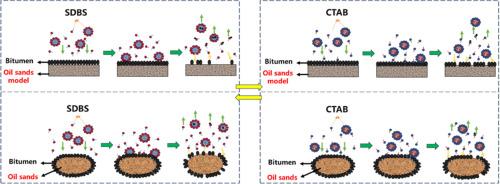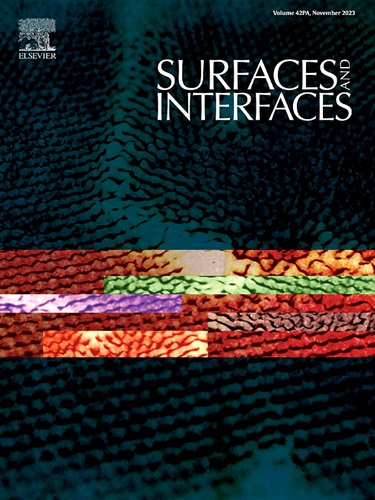Multi-scale evaluation of surfactant effects on asphalt desorption behavior from oil sand surfaces
IF 5.7
2区 材料科学
Q2 CHEMISTRY, PHYSICAL
引用次数: 0
Abstract
This study created a hydrophobic oil sand model to investigate the impact of surfactants on the desorption behavior of asphalt from solid surface. Cationic surfactant cetyl trimethyl ammonium bromide (CTAB) and anionic surfactant sodium dodecyl benzene sulfonate (SDBS) were used to soak the model to observe the effect of surfactants on asphalt desorption. The effect of surfactant pretreatment on the wettability of the substrate was evaluated by measuring the contact angle of ultrapure water on the substrate and observing the morphological changes of the solid surface by atomic force microscopy. The results show that the contact angle of the model treated with SDBS decreases to 10° after 3 days, which significantly improves the wettability of the substrate surface and promotes the desorption of asphalt. However, CTAB has no obvious effect on asphalt desorption. The standard deviation of the gray value of the sand surface image is significantly reduced to 38.693 after the SDBS treatment, which can be seen by binarizing the image. This suggests that the asphalt and solution are evenly distributed and that there is hardly any discernible boundary. Nevertheless, neither of the two surfactants can improve the water-based extraction efficiency of oil sands after soaking treatment. The asphalt yield is <5 % after 30 days of pretreatment with CTAB solution, while only 45 % asphalt yield is obtained after 30 days of pretreatment with SDBS solution. Despite these variations, the quality of asphalt foam remains relatively the same. This may be related to the failure of surfactants to improve the surface wettability of hydrophobic sand. Therefore, the surface wettability of the sand is considered to be a key factor affecting the asphalt desorption and final yield. This study can provide a scientific basis for oil sand recovery to a certain extent.

多尺度评估表面活性剂对油砂表面沥青解吸行为的影响
本研究建立了一个疏水性油砂模型,以研究表面活性剂对沥青从固体表面解吸行为的影响。阳离子表面活性剂十六烷基三甲基溴化铵(CTAB)和阴离子表面活性剂十二烷基苯磺酸钠(SDBS)被用于浸泡模型,以观察表面活性剂对沥青解吸的影响。通过测量超纯水在基底上的接触角和原子力显微镜观察固体表面的形态变化,评估了表面活性剂预处理对基底润湿性的影响。结果表明,经 SDBS 处理的模型的接触角在 3 天后下降到 10°,这显著改善了基底表面的润湿性,促进了沥青的解吸。然而,CTAB 对沥青的解吸作用并不明显。通过对图像进行二值化处理可以看出,SDBS 处理后砂子表面图像灰度值的标准偏差明显降低至 38.693。这表明沥青和溶液分布均匀,几乎没有明显的边界。尽管如此,两种表面活性剂在浸泡处理后都无法提高油砂的水基萃取效率。使用 CTAB 溶液预处理 30 天后,沥青产率为 5%,而使用 SDBS 溶液预处理 30 天后,沥青产率仅为 45%。尽管存在这些差异,泡沫沥青的质量却相对相同。这可能与表面活性剂无法改善疏水性砂的表面润湿性有关。因此,砂的表面润湿性被认为是影响沥青解吸和最终产量的关键因素。这项研究可在一定程度上为油砂回收提供科学依据。
本文章由计算机程序翻译,如有差异,请以英文原文为准。
求助全文
约1分钟内获得全文
求助全文
来源期刊

Surfaces and Interfaces
Chemistry-General Chemistry
CiteScore
8.50
自引率
6.50%
发文量
753
审稿时长
35 days
期刊介绍:
The aim of the journal is to provide a respectful outlet for ''sound science'' papers in all research areas on surfaces and interfaces. We define sound science papers as papers that describe new and well-executed research, but that do not necessarily provide brand new insights or are merely a description of research results.
Surfaces and Interfaces publishes research papers in all fields of surface science which may not always find the right home on first submission to our Elsevier sister journals (Applied Surface, Surface and Coatings Technology, Thin Solid Films)
 求助内容:
求助内容: 应助结果提醒方式:
应助结果提醒方式:


